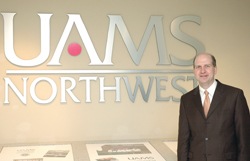Doctor Takes on Challenge of Building Studys Software
by December 12, 2011 11:06 am 79 views

With the initial recruitment phase completed at the Benton County site of the National Children’s Study, the next step is creating the software infrastructure to handle the data gathered over the next two decades.
Dr. William Hogan, chief of the University of Arkansas for Medical Sciences’ Division of Biomedical Informatics, is overseeing that aspect of the study.
Informatics involves classifying, cataloging, storing, analyzing and retrieving information.
The vanguard centers initially used proprietary software for the NCS, but some sites, Hogan said, were asked to look into open-source channels. The Benton County site is one of these.
Open-source computer code or software is available free to the public. It’s often enhanced, improved and adapted for specific purposes by programmers, who then share their revisions.
Using open-source software can save money because there’s no license fee like there is to use Windows or Microsoft Office, Hogan said.
But an even bigger boon for researchers, he said, is its adaptability. Programmers can add the functions they need right away, rather than waiting on the company that owns the source code to make the changes, he said.
“And if you contribute those changes back to the community, then other people can take advantage of them. And at the same time, they’re writing functionality they need, so it’s like everybody benefits from everybody working on improving the software.”
UAMS was already using open-source applications for research at its Winthrop P. Rockefeller Cancer Institute, and Hogan said he saw the opportunity to adapt it for the children’s study.
In turn, UAMS is adapting the children’s study platform for research in other areas, including psychiatry, nursing and cardiology.
“So the vanguard study is also an evaluation and proving ground for open-source information management systems,” Hogan said.
